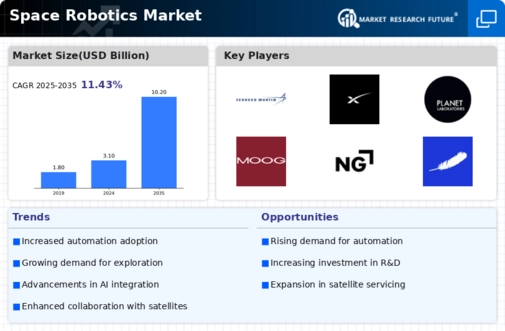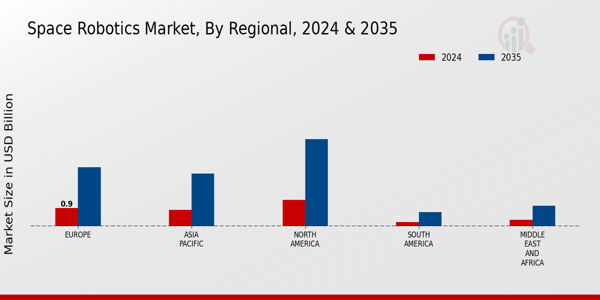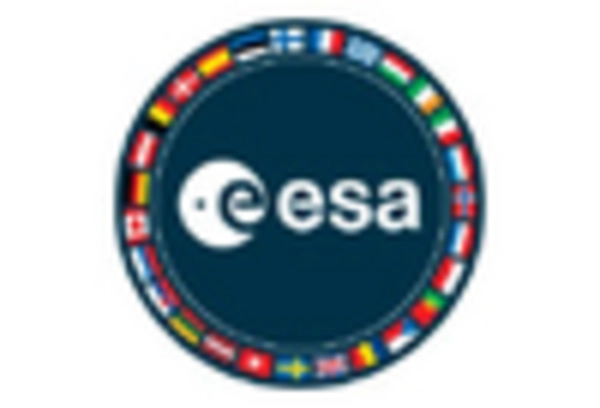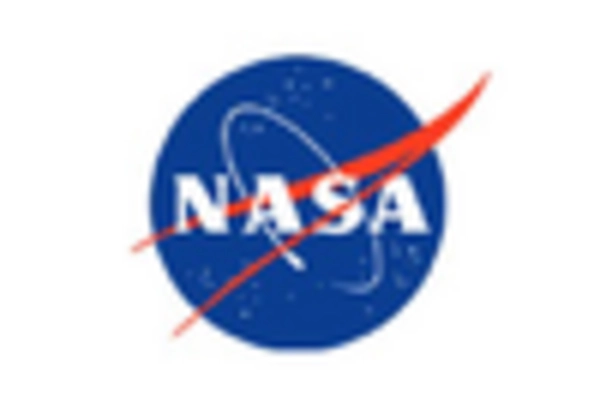-
EXECUTIVE SUMMARY
-
Market Overview
-
Key Findings
-
Market Segmentation
-
Competitive Landscape
-
Challenges and Opportunities
-
Future Outlook
-
MARKET INTRODUCTION
-
Definition
-
Scope of the study
- Research Objective
- Assumption
- Limitations
-
RESEARCH METHODOLOGY
-
Overview
-
Data Mining
-
Secondary Research
-
Primary Research
- Primary Interviews and Information Gathering Process
- Breakdown of Primary Respondents
-
Forecasting Model
-
Market Size Estimation
- Bottom-Up Approach
- Top-Down Approach
-
Data Triangulation
-
Validation
-
MARKET DYNAMICS
-
Overview
-
Drivers
-
Restraints
-
Opportunities
-
MARKET FACTOR ANALYSIS
-
Value chain Analysis
-
Porter's Five Forces Analysis
- Bargaining Power of Suppliers
- Bargaining Power of Buyers
- Threat of New Entrants
- Threat of Substitutes
- Intensity of Rivalry
-
COVID-19 Impact Analysis
- Market Impact Analysis
- Regional Impact
- Opportunity and Threat Analysis
-
SPACE ROBOTICS MARKET, BY APPLICATION (USD BILLION)
-
Satellite Servicing
-
Planetary Exploration
-
Space Construction
-
Space Debris Removal
-
Autonomous Operations
-
SPACE ROBOTICS MARKET, BY TYPE (USD BILLION)
-
Robotic Arms
-
Mobile Robots
-
Remote Operated Vehicles
-
Autonomous Drones
-
SPACE ROBOTICS MARKET, BY FUNCTIONALITY (USD BILLION)
-
Manipulation
-
Inspection
-
Transportation
-
Maintenance
-
SPACE ROBOTICS MARKET, BY END USE (USD BILLION)
-
Government
-
Commercial
-
Research Institutions
-
SPACE ROBOTICS MARKET, BY REGIONAL (USD BILLION)
-
North America
- US
- Canada
-
Europe
- Germany
- UK
- France
- Russia
- Italy
- Spain
- Rest of Europe
-
APAC
- China
- India
- Japan
- South Korea
- Malaysia
- Thailand
- Indonesia
- Rest of APAC
-
South America
- Brazil
- Mexico
- Argentina
- Rest of South America
-
MEA
- GCC Countries
- South Africa
- Rest of MEA
-
COMPETITIVE LANDSCAPE
-
Overview
-
Competitive Analysis
-
Market share Analysis
-
Major Growth Strategy in the Space Robotics Market
-
Competitive Benchmarking
-
Leading Players in Terms of Number of Developments in the Space Robotics Market
-
Key developments and growth strategies
- New Product Launch/Service Deployment
- Merger & Acquisitions
- Joint Ventures
-
Major Players Financial Matrix
- Sales and Operating Income
- Major Players R&D Expenditure. 2023
-
COMPANY PROFILES
-
Robotic Research
- Financial Overview
- Products Offered
- Key Developments
- SWOT Analysis
- Key Strategies
-
Lockheed Martin
- Financial Overview
- Products Offered
- Key Developments
- SWOT Analysis
- Key Strategies
-
Intuitive Surgical
- Financial Overview
- Products Offered
- Key Developments
- SWOT Analysis
- Key Strategies
-
Airbus
- Financial Overview
- Products Offered
- Key Developments
- SWOT Analysis
- Key Strategies
-
SpaceX
- Financial Overview
- Products Offered
- Key Developments
- SWOT Analysis
- Key Strategies
-
Planet Labs
- Financial Overview
- Products Offered
- Key Developments
- SWOT Analysis
- Key Strategies
-
Moog Inc.
- Financial Overview
- Products Offered
- Key Developments
- SWOT Analysis
- Key Strategies
-
Northrop Grumman
- Financial Overview
- Products Offered
- Key Developments
- SWOT Analysis
- Key Strategies
-
Raytheon Technologies
- Financial Overview
- Products Offered
- Key Developments
- SWOT Analysis
- Key Strategies
-
Blue Origin
- Financial Overview
- Products Offered
- Key Developments
- SWOT Analysis
- Key Strategies
-
Maxar Technologies
- Financial Overview
- Products Offered
- Key Developments
- SWOT Analysis
- Key Strategies
-
Terra Bella
- Financial Overview
- Products Offered
- Key Developments
- SWOT Analysis
- Key Strategies
-
Astrobotic Technology
- Financial Overview
- Products Offered
- Key Developments
- SWOT Analysis
- Key Strategies
-
Boeing
- Financial Overview
- Products Offered
- Key Developments
- SWOT Analysis
- Key Strategies
-
NASA
- Financial Overview
- Products Offered
- Key Developments
- SWOT Analysis
- Key Strategies
-
APPENDIX
-
References
-
Related Reports
-
LIST OF TABLES
-
\r\n
-
LIST OF ASSUMPTIONS
-
NORTH AMERICA SPACE ROBOTICS MARKET SIZE ESTIMATES & FORECAST, BY APPLICATION, 2019-2035 (USD BILLIONS)
-
NORTH AMERICA SPACE ROBOTICS MARKET SIZE ESTIMATES & FORECAST, BY TYPE, 2019-2035 (USD BILLIONS)
-
NORTH AMERICA SPACE ROBOTICS MARKET SIZE ESTIMATES & FORECAST, BY FUNCTIONALITY, 2019-2035 (USD BILLIONS)
-
NORTH AMERICA SPACE ROBOTICS MARKET SIZE ESTIMATES & FORECAST, BY END USE, 2019-2035 (USD BILLIONS)
-
NORTH AMERICA SPACE ROBOTICS MARKET SIZE ESTIMATES & FORECAST, BY REGIONAL, 2019-2035 (USD BILLIONS)
-
US SPACE ROBOTICS MARKET SIZE ESTIMATES & FORECAST, BY APPLICATION, 2019-2035 (USD BILLIONS)
-
US SPACE ROBOTICS MARKET SIZE ESTIMATES & FORECAST, BY TYPE, 2019-2035 (USD BILLIONS)
-
US SPACE ROBOTICS MARKET SIZE ESTIMATES & FORECAST, BY FUNCTIONALITY, 2019-2035 (USD BILLIONS)
-
US SPACE ROBOTICS MARKET SIZE ESTIMATES & FORECAST, BY END USE, 2019-2035 (USD BILLIONS)
-
US SPACE ROBOTICS MARKET SIZE ESTIMATES & FORECAST, BY REGIONAL, 2019-2035 (USD BILLIONS)
-
CANADA SPACE ROBOTICS MARKET SIZE ESTIMATES & FORECAST, BY APPLICATION, 2019-2035 (USD BILLIONS)
-
CANADA SPACE ROBOTICS MARKET SIZE ESTIMATES & FORECAST, BY TYPE, 2019-2035 (USD BILLIONS)
-
CANADA SPACE ROBOTICS MARKET SIZE ESTIMATES & FORECAST, BY FUNCTIONALITY, 2019-2035 (USD BILLIONS)
-
CANADA SPACE ROBOTICS MARKET SIZE ESTIMATES & FORECAST, BY END USE, 2019-2035 (USD BILLIONS)
-
CANADA SPACE ROBOTICS MARKET SIZE ESTIMATES & FORECAST, BY REGIONAL, 2019-2035 (USD BILLIONS)
-
EUROPE SPACE ROBOTICS MARKET SIZE ESTIMATES & FORECAST, BY APPLICATION, 2019-2035 (USD BILLIONS)
-
EUROPE SPACE ROBOTICS MARKET SIZE ESTIMATES & FORECAST, BY TYPE, 2019-2035 (USD BILLIONS)
-
EUROPE SPACE ROBOTICS MARKET SIZE ESTIMATES & FORECAST, BY FUNCTIONALITY, 2019-2035 (USD BILLIONS)
-
EUROPE SPACE ROBOTICS MARKET SIZE ESTIMATES & FORECAST, BY END USE, 2019-2035 (USD BILLIONS)
-
EUROPE SPACE ROBOTICS MARKET SIZE ESTIMATES & FORECAST, BY REGIONAL, 2019-2035 (USD BILLIONS)
-
GERMANY SPACE ROBOTICS MARKET SIZE ESTIMATES & FORECAST, BY APPLICATION, 2019-2035 (USD BILLIONS)
-
GERMANY SPACE ROBOTICS MARKET SIZE ESTIMATES & FORECAST, BY TYPE, 2019-2035 (USD BILLIONS)
-
GERMANY SPACE ROBOTICS MARKET SIZE ESTIMATES & FORECAST, BY FUNCTIONALITY, 2019-2035 (USD BILLIONS)
-
GERMANY SPACE ROBOTICS MARKET SIZE ESTIMATES & FORECAST, BY END USE, 2019-2035 (USD BILLIONS)
-
GERMANY SPACE ROBOTICS MARKET SIZE ESTIMATES & FORECAST, BY REGIONAL, 2019-2035 (USD BILLIONS)
-
UK SPACE ROBOTICS MARKET SIZE ESTIMATES & FORECAST, BY APPLICATION, 2019-2035 (USD BILLIONS)
-
UK SPACE ROBOTICS MARKET SIZE ESTIMATES & FORECAST, BY TYPE, 2019-2035 (USD BILLIONS)
-
UK SPACE ROBOTICS MARKET SIZE ESTIMATES & FORECAST, BY FUNCTIONALITY, 2019-2035 (USD BILLIONS)
-
UK SPACE ROBOTICS MARKET SIZE ESTIMATES & FORECAST, BY END USE, 2019-2035 (USD BILLIONS)
-
UK SPACE ROBOTICS MARKET SIZE ESTIMATES & FORECAST, BY REGIONAL, 2019-2035 (USD BILLIONS)
-
FRANCE SPACE ROBOTICS MARKET SIZE ESTIMATES & FORECAST, BY APPLICATION, 2019-2035 (USD BILLIONS)
-
FRANCE SPACE ROBOTICS MARKET SIZE ESTIMATES & FORECAST, BY TYPE, 2019-2035 (USD BILLIONS)
-
FRANCE SPACE ROBOTICS MARKET SIZE ESTIMATES & FORECAST, BY FUNCTIONALITY, 2019-2035 (USD BILLIONS)
-
FRANCE SPACE ROBOTICS MARKET SIZE ESTIMATES & FORECAST, BY END USE, 2019-2035 (USD BILLIONS)
-
FRANCE SPACE ROBOTICS MARKET SIZE ESTIMATES & FORECAST, BY REGIONAL, 2019-2035 (USD BILLIONS)
-
RUSSIA SPACE ROBOTICS MARKET SIZE ESTIMATES & FORECAST, BY APPLICATION, 2019-2035 (USD BILLIONS)
-
RUSSIA SPACE ROBOTICS MARKET SIZE ESTIMATES & FORECAST, BY TYPE, 2019-2035 (USD BILLIONS)
-
RUSSIA SPACE ROBOTICS MARKET SIZE ESTIMATES & FORECAST, BY FUNCTIONALITY, 2019-2035 (USD BILLIONS)
-
RUSSIA SPACE ROBOTICS MARKET SIZE ESTIMATES & FORECAST, BY END USE, 2019-2035 (USD BILLIONS)
-
RUSSIA SPACE ROBOTICS MARKET SIZE ESTIMATES & FORECAST, BY REGIONAL, 2019-2035 (USD BILLIONS)
-
ITALY SPACE ROBOTICS MARKET SIZE ESTIMATES & FORECAST, BY APPLICATION, 2019-2035 (USD BILLIONS)
-
ITALY SPACE ROBOTICS MARKET SIZE ESTIMATES & FORECAST, BY TYPE, 2019-2035 (USD BILLIONS)
-
ITALY SPACE ROBOTICS MARKET SIZE ESTIMATES & FORECAST, BY FUNCTIONALITY, 2019-2035 (USD BILLIONS)
-
ITALY SPACE ROBOTICS MARKET SIZE ESTIMATES & FORECAST, BY END USE, 2019-2035 (USD BILLIONS)
-
ITALY SPACE ROBOTICS MARKET SIZE ESTIMATES & FORECAST, BY REGIONAL, 2019-2035 (USD BILLIONS)
-
SPAIN SPACE ROBOTICS MARKET SIZE ESTIMATES & FORECAST, BY APPLICATION, 2019-2035 (USD BILLIONS)
-
SPAIN SPACE ROBOTICS MARKET SIZE ESTIMATES & FORECAST, BY TYPE, 2019-2035 (USD BILLIONS)
-
SPAIN SPACE ROBOTICS MARKET SIZE ESTIMATES & FORECAST, BY FUNCTIONALITY, 2019-2035 (USD BILLIONS)
-
SPAIN SPACE ROBOTICS MARKET SIZE ESTIMATES & FORECAST, BY END USE, 2019-2035 (USD BILLIONS)
-
SPAIN SPACE ROBOTICS MARKET SIZE ESTIMATES & FORECAST, BY REGIONAL, 2019-2035 (USD BILLIONS)
-
REST OF EUROPE SPACE ROBOTICS MARKET SIZE ESTIMATES & FORECAST, BY APPLICATION, 2019-2035 (USD BILLIONS)
-
REST OF EUROPE SPACE ROBOTICS MARKET SIZE ESTIMATES & FORECAST, BY TYPE, 2019-2035 (USD BILLIONS)
-
REST OF EUROPE SPACE ROBOTICS MARKET SIZE ESTIMATES & FORECAST, BY FUNCTIONALITY, 2019-2035 (USD BILLIONS)
-
REST OF EUROPE SPACE ROBOTICS MARKET SIZE ESTIMATES & FORECAST, BY END USE, 2019-2035 (USD BILLIONS)
-
REST OF EUROPE SPACE ROBOTICS MARKET SIZE ESTIMATES & FORECAST, BY REGIONAL, 2019-2035 (USD BILLIONS)
-
APAC SPACE ROBOTICS MARKET SIZE ESTIMATES & FORECAST, BY APPLICATION, 2019-2035 (USD BILLIONS)
-
APAC SPACE ROBOTICS MARKET SIZE ESTIMATES & FORECAST, BY TYPE, 2019-2035 (USD BILLIONS)
-
APAC SPACE ROBOTICS MARKET SIZE ESTIMATES & FORECAST, BY FUNCTIONALITY, 2019-2035 (USD BILLIONS)
-
APAC SPACE ROBOTICS MARKET SIZE ESTIMATES & FORECAST, BY END USE, 2019-2035 (USD BILLIONS)
-
APAC SPACE ROBOTICS MARKET SIZE ESTIMATES & FORECAST, BY REGIONAL, 2019-2035 (USD BILLIONS)
-
CHINA SPACE ROBOTICS MARKET SIZE ESTIMATES & FORECAST, BY APPLICATION, 2019-2035 (USD BILLIONS)
-
CHINA SPACE ROBOTICS MARKET SIZE ESTIMATES & FORECAST, BY TYPE, 2019-2035 (USD BILLIONS)
-
CHINA SPACE ROBOTICS MARKET SIZE ESTIMATES & FORECAST, BY FUNCTIONALITY, 2019-2035 (USD BILLIONS)
-
CHINA SPACE ROBOTICS MARKET SIZE ESTIMATES & FORECAST, BY END USE, 2019-2035 (USD BILLIONS)
-
CHINA SPACE ROBOTICS MARKET SIZE ESTIMATES & FORECAST, BY REGIONAL, 2019-2035 (USD BILLIONS)
-
INDIA SPACE ROBOTICS MARKET SIZE ESTIMATES & FORECAST, BY APPLICATION, 2019-2035 (USD BILLIONS)
-
INDIA SPACE ROBOTICS MARKET SIZE ESTIMATES & FORECAST, BY TYPE, 2019-2035 (USD BILLIONS)
-
INDIA SPACE ROBOTICS MARKET SIZE ESTIMATES & FORECAST, BY FUNCTIONALITY, 2019-2035 (USD BILLIONS)
-
INDIA SPACE ROBOTICS MARKET SIZE ESTIMATES & FORECAST, BY END USE, 2019-2035 (USD BILLIONS)
-
INDIA SPACE ROBOTICS MARKET SIZE ESTIMATES & FORECAST, BY REGIONAL, 2019-2035 (USD BILLIONS)
-
JAPAN SPACE ROBOTICS MARKET SIZE ESTIMATES & FORECAST, BY APPLICATION, 2019-2035 (USD BILLIONS)
-
JAPAN SPACE ROBOTICS MARKET SIZE ESTIMATES & FORECAST, BY TYPE, 2019-2035 (USD BILLIONS)
-
JAPAN SPACE ROBOTICS MARKET SIZE ESTIMATES & FORECAST, BY FUNCTIONALITY, 2019-2035 (USD BILLIONS)
-
JAPAN SPACE ROBOTICS MARKET SIZE ESTIMATES & FORECAST, BY END USE, 2019-2035 (USD BILLIONS)
-
JAPAN SPACE ROBOTICS MARKET SIZE ESTIMATES & FORECAST, BY REGIONAL, 2019-2035 (USD BILLIONS)
-
SOUTH KOREA SPACE ROBOTICS MARKET SIZE ESTIMATES & FORECAST, BY APPLICATION, 2019-2035 (USD BILLIONS)
-
SOUTH KOREA SPACE ROBOTICS MARKET SIZE ESTIMATES & FORECAST, BY TYPE, 2019-2035 (USD BILLIONS)
-
SOUTH KOREA SPACE ROBOTICS MARKET SIZE ESTIMATES & FORECAST, BY FUNCTIONALITY, 2019-2035 (USD BILLIONS)
-
SOUTH KOREA SPACE ROBOTICS MARKET SIZE ESTIMATES & FORECAST, BY END USE, 2019-2035 (USD BILLIONS)
-
SOUTH KOREA SPACE ROBOTICS MARKET SIZE ESTIMATES & FORECAST, BY REGIONAL, 2019-2035 (USD BILLIONS)
-
MALAYSIA SPACE ROBOTICS MARKET SIZE ESTIMATES & FORECAST, BY APPLICATION, 2019-2035 (USD BILLIONS)
-
MALAYSIA SPACE ROBOTICS MARKET SIZE ESTIMATES & FORECAST, BY TYPE, 2019-2035 (USD BILLIONS)
-
MALAYSIA SPACE ROBOTICS MARKET SIZE ESTIMATES & FORECAST, BY FUNCTIONALITY, 2019-2035 (USD BILLIONS)
-
MALAYSIA SPACE ROBOTICS MARKET SIZE ESTIMATES & FORECAST, BY END USE, 2019-2035 (USD BILLIONS)
-
MALAYSIA SPACE ROBOTICS MARKET SIZE ESTIMATES & FORECAST, BY REGIONAL, 2019-2035 (USD BILLIONS)
-
THAILAND SPACE ROBOTICS MARKET SIZE ESTIMATES & FORECAST, BY APPLICATION, 2019-2035 (USD BILLIONS)
-
THAILAND SPACE ROBOTICS MARKET SIZE ESTIMATES & FORECAST, BY TYPE, 2019-2035 (USD BILLIONS)
-
THAILAND SPACE ROBOTICS MARKET SIZE ESTIMATES & FORECAST, BY FUNCTIONALITY, 2019-2035 (USD BILLIONS)
-
THAILAND SPACE ROBOTICS MARKET SIZE ESTIMATES & FORECAST, BY END USE, 2019-2035 (USD BILLIONS)
-
THAILAND SPACE ROBOTICS MARKET SIZE ESTIMATES & FORECAST, BY REGIONAL, 2019-2035 (USD BILLIONS)
-
INDONESIA SPACE ROBOTICS MARKET SIZE ESTIMATES & FORECAST, BY APPLICATION, 2019-2035 (USD BILLIONS)
-
INDONESIA SPACE ROBOTICS MARKET SIZE ESTIMATES & FORECAST, BY TYPE, 2019-2035 (USD BILLIONS)
-
INDONESIA SPACE ROBOTICS MARKET SIZE ESTIMATES & FORECAST, BY FUNCTIONALITY, 2019-2035 (USD BILLIONS)
-
INDONESIA SPACE ROBOTICS MARKET SIZE ESTIMATES & FORECAST, BY END USE, 2019-2035 (USD BILLIONS)
-
INDONESIA SPACE ROBOTICS MARKET SIZE ESTIMATES & FORECAST, BY REGIONAL, 2019-2035 (USD BILLIONS)
-
REST OF APAC SPACE ROBOTICS MARKET SIZE ESTIMATES & FORECAST, BY APPLICATION, 2019-2035 (USD BILLIONS)
-
REST OF APAC SPACE ROBOTICS MARKET SIZE ESTIMATES & FORECAST, BY TYPE, 2019-2035 (USD BILLIONS)
-
REST OF APAC SPACE ROBOTICS MARKET SIZE ESTIMATES & FORECAST, BY FUNCTIONALITY, 2019-2035 (USD BILLIONS)
-
REST OF APAC SPACE ROBOTICS MARKET SIZE ESTIMATES & FORECAST, BY END USE, 2019-2035 (USD BILLIONS)
-
REST OF APAC SPACE ROBOTICS MARKET SIZE ESTIMATES & FORECAST, BY REGIONAL, 2019-2035 (USD BILLIONS)
-
SOUTH AMERICA SPACE ROBOTICS MARKET SIZE ESTIMATES & FORECAST, BY APPLICATION, 2019-2035 (USD BILLIONS)
-
SOUTH AMERICA SPACE ROBOTICS MARKET SIZE ESTIMATES & FORECAST, BY TYPE, 2019-2035 (USD BILLIONS)
-
SOUTH AMERICA SPACE ROBOTICS MARKET SIZE ESTIMATES & FORECAST, BY FUNCTIONALITY, 2019-2035 (USD BILLIONS)
-
SOUTH AMERICA SPACE ROBOTICS MARKET SIZE ESTIMATES & FORECAST, BY END USE, 2019-2035 (USD BILLIONS)
-
SOUTH AMERICA SPACE ROBOTICS MARKET SIZE ESTIMATES & FORECAST, BY REGIONAL, 2019-2035 (USD BILLIONS)
-
BRAZIL SPACE ROBOTICS MARKET SIZE ESTIMATES & FORECAST, BY APPLICATION, 2019-2035 (USD BILLIONS)
-
BRAZIL SPACE ROBOTICS MARKET SIZE ESTIMATES & FORECAST, BY TYPE, 2019-2035 (USD BILLIONS)
-
BRAZIL SPACE ROBOTICS MARKET SIZE ESTIMATES & FORECAST, BY FUNCTIONALITY, 2019-2035 (USD BILLIONS)
-
BRAZIL SPACE ROBOTICS MARKET SIZE ESTIMATES & FORECAST, BY END USE, 2019-2035 (USD BILLIONS)
-
BRAZIL SPACE ROBOTICS MARKET SIZE ESTIMATES & FORECAST, BY REGIONAL, 2019-2035 (USD BILLIONS)
-
MEXICO SPACE ROBOTICS MARKET SIZE ESTIMATES & FORECAST, BY APPLICATION, 2019-2035 (USD BILLIONS)
-
MEXICO SPACE ROBOTICS MARKET SIZE ESTIMATES & FORECAST, BY TYPE, 2019-2035 (USD BILLIONS)
-
MEXICO SPACE ROBOTICS MARKET SIZE ESTIMATES & FORECAST, BY FUNCTIONALITY, 2019-2035 (USD BILLIONS)
-
MEXICO SPACE ROBOTICS MARKET SIZE ESTIMATES & FORECAST, BY END USE, 2019-2035 (USD BILLIONS)
-
MEXICO SPACE ROBOTICS MARKET SIZE ESTIMATES & FORECAST, BY REGIONAL, 2019-2035 (USD BILLIONS)
-
ARGENTINA SPACE ROBOTICS MARKET SIZE ESTIMATES & FORECAST, BY APPLICATION, 2019-2035 (USD BILLIONS)
-
ARGENTINA SPACE ROBOTICS MARKET SIZE ESTIMATES & FORECAST, BY TYPE, 2019-2035 (USD BILLIONS)
-
ARGENTINA SPACE ROBOTICS MARKET SIZE ESTIMATES & FORECAST, BY FUNCTIONALITY, 2019-2035 (USD BILLIONS)
-
ARGENTINA SPACE ROBOTICS MARKET SIZE ESTIMATES & FORECAST, BY END USE, 2019-2035 (USD BILLIONS)
-
ARGENTINA SPACE ROBOTICS MARKET SIZE ESTIMATES & FORECAST, BY REGIONAL, 2019-2035 (USD BILLIONS)
-
REST OF SOUTH AMERICA SPACE ROBOTICS MARKET SIZE ESTIMATES & FORECAST, BY APPLICATION, 2019-2035 (USD BILLIONS)
-
REST OF SOUTH AMERICA SPACE ROBOTICS MARKET SIZE ESTIMATES & FORECAST, BY TYPE, 2019-2035 (USD BILLIONS)
-
REST OF SOUTH AMERICA SPACE ROBOTICS MARKET SIZE ESTIMATES & FORECAST, BY FUNCTIONALITY, 2019-2035 (USD BILLIONS)
-
REST OF SOUTH AMERICA SPACE ROBOTICS MARKET SIZE ESTIMATES & FORECAST, BY END USE, 2019-2035 (USD BILLIONS)
-
REST OF SOUTH AMERICA SPACE ROBOTICS MARKET SIZE ESTIMATES & FORECAST, BY REGIONAL, 2019-2035 (USD BILLIONS)
-
MEA SPACE ROBOTICS MARKET SIZE ESTIMATES & FORECAST, BY APPLICATION, 2019-2035 (USD BILLIONS)
-
MEA SPACE ROBOTICS MARKET SIZE ESTIMATES & FORECAST, BY TYPE, 2019-2035 (USD BILLIONS)
-
MEA SPACE ROBOTICS MARKET SIZE ESTIMATES & FORECAST, BY FUNCTIONALITY, 2019-2035 (USD BILLIONS)
-
MEA SPACE ROBOTICS MARKET SIZE ESTIMATES & FORECAST, BY END USE, 2019-2035 (USD BILLIONS)
-
MEA SPACE ROBOTICS MARKET SIZE ESTIMATES & FORECAST, BY REGIONAL, 2019-2035 (USD BILLIONS)
-
GCC COUNTRIES SPACE ROBOTICS MARKET SIZE ESTIMATES & FORECAST, BY APPLICATION, 2019-2035 (USD BILLIONS)
-
GCC COUNTRIES SPACE ROBOTICS MARKET SIZE ESTIMATES & FORECAST, BY TYPE, 2019-2035 (USD BILLIONS)
-
GCC COUNTRIES SPACE ROBOTICS MARKET SIZE ESTIMATES & FORECAST, BY FUNCTIONALITY, 2019-2035 (USD BILLIONS)
-
GCC COUNTRIES SPACE ROBOTICS MARKET SIZE ESTIMATES & FORECAST, BY END USE, 2019-2035 (USD BILLIONS)
-
GCC COUNTRIES SPACE ROBOTICS MARKET SIZE ESTIMATES & FORECAST, BY REGIONAL, 2019-2035 (USD BILLIONS)
-
SOUTH AFRICA SPACE ROBOTICS MARKET SIZE ESTIMATES & FORECAST, BY APPLICATION, 2019-2035 (USD BILLIONS)
-
SOUTH AFRICA SPACE ROBOTICS MARKET SIZE ESTIMATES & FORECAST, BY TYPE, 2019-2035 (USD BILLIONS)
-
SOUTH AFRICA SPACE ROBOTICS MARKET SIZE ESTIMATES & FORECAST, BY FUNCTIONALITY, 2019-2035 (USD BILLIONS)
-
SOUTH AFRICA SPACE ROBOTICS MARKET SIZE ESTIMATES & FORECAST, BY END USE, 2019-2035 (USD BILLIONS)
-
SOUTH AFRICA SPACE ROBOTICS MARKET SIZE ESTIMATES & FORECAST, BY REGIONAL, 2019-2035 (USD BILLIONS)
-
REST OF MEA SPACE ROBOTICS MARKET SIZE ESTIMATES & FORECAST, BY APPLICATION, 2019-2035 (USD BILLIONS)
-
REST OF MEA SPACE ROBOTICS MARKET SIZE ESTIMATES & FORECAST, BY TYPE, 2019-2035 (USD BILLIONS)
-
REST OF MEA SPACE ROBOTICS MARKET SIZE ESTIMATES & FORECAST, BY FUNCTIONALITY, 2019-2035 (USD BILLIONS)
-
REST OF MEA SPACE ROBOTICS MARKET SIZE ESTIMATES & FORECAST, BY END USE, 2019-2035 (USD BILLIONS)
-
REST OF MEA SPACE ROBOTICS MARKET SIZE ESTIMATES & FORECAST, BY REGIONAL, 2019-2035 (USD BILLIONS)
-
PRODUCT LAUNCH/PRODUCT DEVELOPMENT/APPROVAL
-
ACQUISITION/PARTNERSHIP
-
\r\n
-
LIST OF FIGURES
-
\r\n
-
MARKET SYNOPSIS
-
NORTH AMERICA SPACE ROBOTICS MARKET ANALYSIS
-
US SPACE ROBOTICS MARKET ANALYSIS BY APPLICATION
-
US SPACE ROBOTICS MARKET ANALYSIS BY TYPE
-
US SPACE ROBOTICS MARKET ANALYSIS BY FUNCTIONALITY
-
US SPACE ROBOTICS MARKET ANALYSIS BY END USE
-
US SPACE ROBOTICS MARKET ANALYSIS BY REGIONAL
-
CANADA SPACE ROBOTICS MARKET ANALYSIS BY APPLICATION
-
CANADA SPACE ROBOTICS MARKET ANALYSIS BY TYPE
-
CANADA SPACE ROBOTICS MARKET ANALYSIS BY FUNCTIONALITY
-
CANADA SPACE ROBOTICS MARKET ANALYSIS BY END USE
-
CANADA SPACE ROBOTICS MARKET ANALYSIS BY REGIONAL
-
EUROPE SPACE ROBOTICS MARKET ANALYSIS
-
GERMANY SPACE ROBOTICS MARKET ANALYSIS BY APPLICATION
-
GERMANY SPACE ROBOTICS MARKET ANALYSIS BY TYPE
-
GERMANY SPACE ROBOTICS MARKET ANALYSIS BY FUNCTIONALITY
-
GERMANY SPACE ROBOTICS MARKET ANALYSIS BY END USE
-
GERMANY SPACE ROBOTICS MARKET ANALYSIS BY REGIONAL
-
UK SPACE ROBOTICS MARKET ANALYSIS BY APPLICATION
-
UK SPACE ROBOTICS MARKET ANALYSIS BY TYPE
-
UK SPACE ROBOTICS MARKET ANALYSIS BY FUNCTIONALITY
-
UK SPACE ROBOTICS MARKET ANALYSIS BY END USE
-
UK SPACE ROBOTICS MARKET ANALYSIS BY REGIONAL
-
FRANCE SPACE ROBOTICS MARKET ANALYSIS BY APPLICATION
-
FRANCE SPACE ROBOTICS MARKET ANALYSIS BY TYPE
-
FRANCE SPACE ROBOTICS MARKET ANALYSIS BY FUNCTIONALITY
-
FRANCE SPACE ROBOTICS MARKET ANALYSIS BY END USE
-
FRANCE SPACE ROBOTICS MARKET ANALYSIS BY REGIONAL
-
RUSSIA SPACE ROBOTICS MARKET ANALYSIS BY APPLICATION
-
RUSSIA SPACE ROBOTICS MARKET ANALYSIS BY TYPE
-
RUSSIA SPACE ROBOTICS MARKET ANALYSIS BY FUNCTIONALITY
-
RUSSIA SPACE ROBOTICS MARKET ANALYSIS BY END USE
-
RUSSIA SPACE ROBOTICS MARKET ANALYSIS BY REGIONAL
-
ITALY SPACE ROBOTICS MARKET ANALYSIS BY APPLICATION
-
ITALY SPACE ROBOTICS MARKET ANALYSIS BY TYPE
-
ITALY SPACE ROBOTICS MARKET ANALYSIS BY FUNCTIONALITY
-
ITALY SPACE ROBOTICS MARKET ANALYSIS BY END USE
-
ITALY SPACE ROBOTICS MARKET ANALYSIS BY REGIONAL
-
SPAIN SPACE ROBOTICS MARKET ANALYSIS BY APPLICATION
-
SPAIN SPACE ROBOTICS MARKET ANALYSIS BY TYPE
-
SPAIN SPACE ROBOTICS MARKET ANALYSIS BY FUNCTIONALITY
-
SPAIN SPACE ROBOTICS MARKET ANALYSIS BY END USE
-
SPAIN SPACE ROBOTICS MARKET ANALYSIS BY REGIONAL
-
REST OF EUROPE SPACE ROBOTICS MARKET ANALYSIS BY APPLICATION
-
REST OF EUROPE SPACE ROBOTICS MARKET ANALYSIS BY TYPE
-
REST OF EUROPE SPACE ROBOTICS MARKET ANALYSIS BY FUNCTIONALITY
-
REST OF EUROPE SPACE ROBOTICS MARKET ANALYSIS BY END USE
-
REST OF EUROPE SPACE ROBOTICS MARKET ANALYSIS BY REGIONAL
-
APAC SPACE ROBOTICS MARKET ANALYSIS
-
CHINA SPACE ROBOTICS MARKET ANALYSIS BY APPLICATION
-
CHINA SPACE ROBOTICS MARKET ANALYSIS BY TYPE
-
CHINA SPACE ROBOTICS MARKET ANALYSIS BY FUNCTIONALITY
-
CHINA SPACE ROBOTICS MARKET ANALYSIS BY END USE
-
CHINA SPACE ROBOTICS MARKET ANALYSIS BY REGIONAL
-
INDIA SPACE ROBOTICS MARKET ANALYSIS BY APPLICATION
-
INDIA SPACE ROBOTICS MARKET ANALYSIS BY TYPE
-
INDIA SPACE ROBOTICS MARKET ANALYSIS BY FUNCTIONALITY
-
INDIA SPACE ROBOTICS MARKET ANALYSIS BY END USE
-
INDIA SPACE ROBOTICS MARKET ANALYSIS BY REGIONAL
-
JAPAN SPACE ROBOTICS MARKET ANALYSIS BY APPLICATION
-
JAPAN SPACE ROBOTICS MARKET ANALYSIS BY TYPE
-
JAPAN SPACE ROBOTICS MARKET ANALYSIS BY FUNCTIONALITY
-
JAPAN SPACE ROBOTICS MARKET ANALYSIS BY END USE
-
JAPAN SPACE ROBOTICS MARKET ANALYSIS BY REGIONAL
-
SOUTH KOREA SPACE ROBOTICS MARKET ANALYSIS BY APPLICATION
-
SOUTH KOREA SPACE ROBOTICS MARKET ANALYSIS BY TYPE
-
SOUTH KOREA SPACE ROBOTICS MARKET ANALYSIS BY FUNCTIONALITY
-
SOUTH KOREA SPACE ROBOTICS MARKET ANALYSIS BY END USE
-
SOUTH KOREA SPACE ROBOTICS MARKET ANALYSIS BY REGIONAL
-
MALAYSIA SPACE ROBOTICS MARKET ANALYSIS BY APPLICATION
-
MALAYSIA SPACE ROBOTICS MARKET ANALYSIS BY TYPE
-
MALAYSIA SPACE ROBOTICS MARKET ANALYSIS BY FUNCTIONALITY
-
MALAYSIA SPACE ROBOTICS MARKET ANALYSIS BY END USE
-
MALAYSIA SPACE ROBOTICS MARKET ANALYSIS BY REGIONAL
-
THAILAND SPACE ROBOTICS MARKET ANALYSIS BY APPLICATION
-
THAILAND SPACE ROBOTICS MARKET ANALYSIS BY TYPE
-
THAILAND SPACE ROBOTICS MARKET ANALYSIS BY FUNCTIONALITY
-
THAILAND SPACE ROBOTICS MARKET ANALYSIS BY END USE
-
THAILAND SPACE ROBOTICS MARKET ANALYSIS BY REGIONAL
-
INDONESIA SPACE ROBOTICS MARKET ANALYSIS BY APPLICATION
-
INDONESIA SPACE ROBOTICS MARKET ANALYSIS BY TYPE
-
INDONESIA SPACE ROBOTICS MARKET ANALYSIS BY FUNCTIONALITY
-
INDONESIA SPACE ROBOTICS MARKET ANALYSIS BY END USE
-
INDONESIA SPACE ROBOTICS MARKET ANALYSIS BY REGIONAL
-
REST OF APAC SPACE ROBOTICS MARKET ANALYSIS BY APPLICATION
-
REST OF APAC SPACE ROBOTICS MARKET ANALYSIS BY TYPE
-
REST OF APAC SPACE ROBOTICS MARKET ANALYSIS BY FUNCTIONALITY
-
REST OF APAC SPACE ROBOTICS MARKET ANALYSIS BY END USE
-
REST OF APAC SPACE ROBOTICS MARKET ANALYSIS BY REGIONAL
-
SOUTH AMERICA SPACE ROBOTICS MARKET ANALYSIS
-
BRAZIL SPACE ROBOTICS MARKET ANALYSIS BY APPLICATION
-
BRAZIL SPACE ROBOTICS MARKET ANALYSIS BY TYPE
-
BRAZIL SPACE ROBOTICS MARKET ANALYSIS BY FUNCTIONALITY
-
BRAZIL SPACE ROBOTICS MARKET ANALYSIS BY END USE
-
BRAZIL SPACE ROBOTICS MARKET ANALYSIS BY REGIONAL
-
MEXICO SPACE ROBOTICS MARKET ANALYSIS BY APPLICATION
-
MEXICO SPACE ROBOTICS MARKET ANALYSIS BY TYPE
-
MEXICO SPACE ROBOTICS MARKET ANALYSIS BY FUNCTIONALITY
-
MEXICO SPACE ROBOTICS MARKET ANALYSIS BY END USE
-
MEXICO SPACE ROBOTICS MARKET ANALYSIS BY REGIONAL
-
ARGENTINA SPACE ROBOTICS MARKET ANALYSIS BY APPLICATION
-
ARGENTINA SPACE ROBOTICS MARKET ANALYSIS BY TYPE
-
ARGENTINA SPACE ROBOTICS MARKET ANALYSIS BY FUNCTIONALITY
-
ARGENTINA SPACE ROBOTICS MARKET ANALYSIS BY END USE
-
ARGENTINA SPACE ROBOTICS MARKET ANALYSIS BY REGIONAL
-
REST OF SOUTH AMERICA SPACE ROBOTICS MARKET ANALYSIS BY APPLICATION
-
REST OF SOUTH AMERICA SPACE ROBOTICS MARKET ANALYSIS BY TYPE
-
REST OF SOUTH AMERICA SPACE ROBOTICS MARKET ANALYSIS BY FUNCTIONALITY
-
REST OF SOUTH AMERICA SPACE ROBOTICS MARKET ANALYSIS BY END USE
-
REST OF SOUTH AMERICA SPACE ROBOTICS MARKET ANALYSIS BY REGIONAL
-
MEA SPACE ROBOTICS MARKET ANALYSIS
-
GCC COUNTRIES SPACE ROBOTICS MARKET ANALYSIS BY APPLICATION
-
GCC COUNTRIES SPACE ROBOTICS MARKET ANALYSIS BY TYPE
-
GCC COUNTRIES SPACE ROBOTICS MARKET ANALYSIS BY FUNCTIONALITY
-
GCC COUNTRIES SPACE ROBOTICS MARKET ANALYSIS BY END USE
-
GCC COUNTRIES SPACE ROBOTICS MARKET ANALYSIS BY REGIONAL
-
SOUTH AFRICA SPACE ROBOTICS MARKET ANALYSIS BY APPLICATION
-
SOUTH AFRICA SPACE ROBOTICS MARKET ANALYSIS BY TYPE
-
SOUTH AFRICA SPACE ROBOTICS MARKET ANALYSIS BY FUNCTIONALITY
-
SOUTH AFRICA SPACE ROBOTICS MARKET ANALYSIS BY END USE
-
SOUTH AFRICA SPACE ROBOTICS MARKET ANALYSIS BY REGIONAL
-
REST OF MEA SPACE ROBOTICS MARKET ANALYSIS BY APPLICATION
-
REST OF MEA SPACE ROBOTICS MARKET ANALYSIS BY TYPE
-
REST OF MEA SPACE ROBOTICS MARKET ANALYSIS BY FUNCTIONALITY
-
REST OF MEA SPACE ROBOTICS MARKET ANALYSIS BY END USE
-
REST OF MEA SPACE ROBOTICS MARKET ANALYSIS BY REGIONAL
-
KEY BUYING CRITERIA OF SPACE ROBOTICS MARKET
-
RESEARCH PROCESS OF MRFR
-
DRO ANALYSIS OF SPACE ROBOTICS MARKET
-
DRIVERS IMPACT ANALYSIS: SPACE ROBOTICS MARKET
-
RESTRAINTS IMPACT ANALYSIS: SPACE ROBOTICS MARKET
-
SUPPLY / VALUE CHAIN: SPACE ROBOTICS MARKET
-
SPACE ROBOTICS MARKET, BY APPLICATION, 2025 (% SHARE)
-
SPACE ROBOTICS MARKET, BY APPLICATION, 2019 TO 2035 (USD Billions)
-
SPACE ROBOTICS MARKET, BY TYPE, 2025 (% SHARE)
-
SPACE ROBOTICS MARKET, BY TYPE, 2019 TO 2035 (USD Billions)
-
SPACE ROBOTICS MARKET, BY FUNCTIONALITY, 2025 (% SHARE)
-
SPACE ROBOTICS MARKET, BY FUNCTIONALITY, 2019 TO 2035 (USD Billions)
-
SPACE ROBOTICS MARKET, BY END USE, 2025 (% SHARE)
-
SPACE ROBOTICS MARKET, BY END USE, 2019 TO 2035 (USD Billions)
-
SPACE ROBOTICS MARKET, BY REGIONAL, 2025 (% SHARE)
-
SPACE ROBOTICS MARKET, BY REGIONAL, 2019 TO 2035 (USD Billions)
-
BENCHMARKING OF MAJOR COMPETITORS
-
"










Leave a Comment